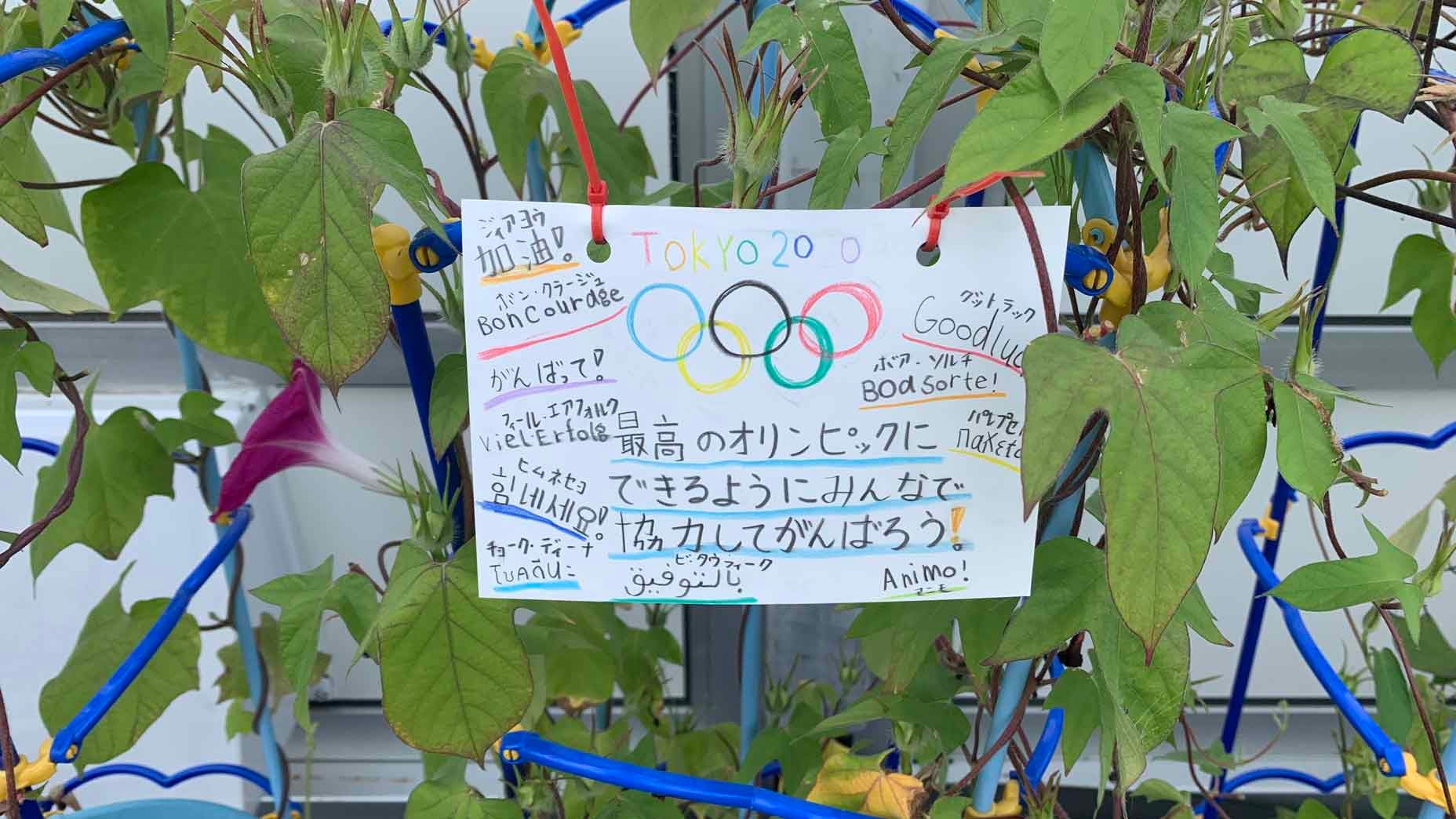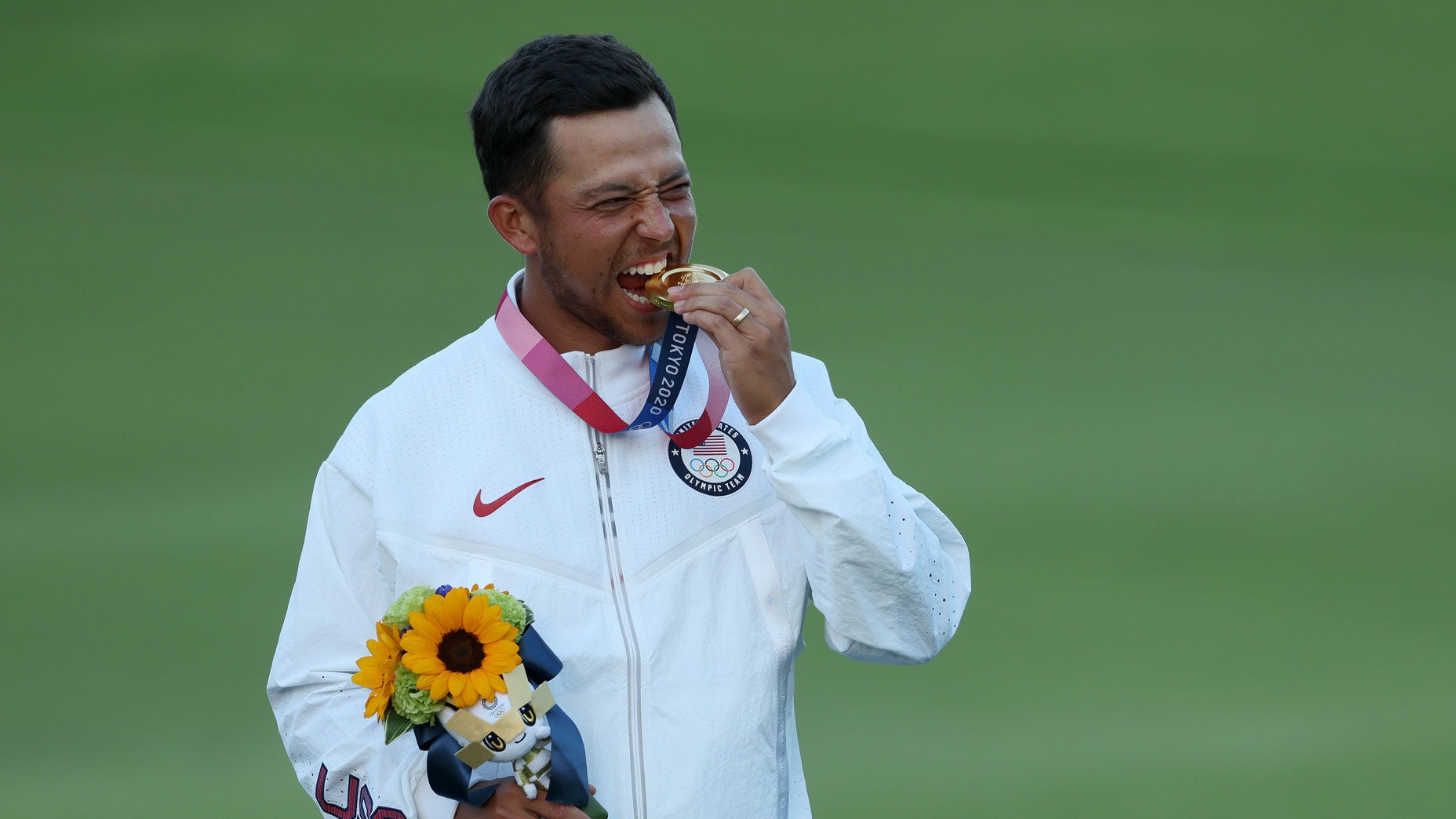
Nelly Korda took a gold medal back to the U.S.
Getty Images
The Tokyo Olympics will always be remembered for being played during a pandemic, with all kinds of restrictions on movement for media, athletes, taxi drivers, etc. It certainly wasn’t the version of Japan I wanted to see, but as Xander’s father Stefan Schauffele reminded me on the day his son won the gold medal: “It’s all about attitude coming over here.”
What I did enjoy was 12 days of largely unfettered access to the golf course and some of the best players in the world. No fans to weave around. No one really checking my badge to see that I was in the right place … or the wrong place. Plenty of time in the sweltering heat on the range, a late afternoon lunch during a weather delay in the player’s clubhouse, inside the ropes with Nelly Korda and outside the ropes with Team Great Britain. The notebook was open the entire time, literally and figuratively. Here are a bunch of things I saw, heard and learned during my two weeks at the Olympics.
1. How about that 18th hole? I had begun my time in Japan disliking Kasumigaseki’s finisher. The hazard short and right of the green is the only in-play water hazard on the course. It felt a bit forced on first glance, but it was clearly top of mind whenever any player missed the fairway. After playing it for the first time, Tommy Fleetwood’s caddie Ian Finnis put it simply: “Good hole. Good, good hole.”
You love to see that for the 72nd hole of any major event. The 18th at Augusta National is fine. The finisher at Torrey Pines is solid. No. 18 at Royal St. George’s? Frankly, it’s a bit hard to remember. But with the unpredictable rough and the perfectly placed fairway bunker, Finnis was right. A good, good hole. And it drove Tommy crazy all week.
2. The Sebonack logo travels. I packed one hat — a white ball cap with that snaking ’S’ Sebonack logo — and wore it every single day. Fleetwood was the first to ask about it. Then some caddie joined him. And another caddie after that, during the final round. I answered the question, “Is that Sebonack?” no less than five times at a fan-less golf course where most of the people on property didn’t speak any english. The logo is extremely simple, but apparently it sticks out in the minds of golf fans. No, I’m not a member, just a gracious guest.
3. Speaking of elite Long Island courses, Fleetwood is your best tour guide. The first time he played Sebonack, years ago, it was with a half-set, and it ended with him six under through nine holes. As a result, the next time he teed it up there, during his epic quarantine return to the States, Sebonack was ready for him. Apparently after “Fleetwood” was registered on the tee sheet, the course was set up to make sure he could not break par. “I didn’t sign up for this,” he laughed, retelling the story.
That two-week stretch where he and Finnis bounced around some of the best courses in the world was understandably one of the greatest trips of their lives. They’d tell you all about it, just like they told me all about it. Maidstone, Sebonack, Shinnecock, National Golf Links. All the greats. When asked for his favorite, Fleetwood said, “If I had to play one every day, like as a member, it’d be National [Golf Links].” Not going to find much opposition there. He enjoyed how wide open it is off the tee, and from there it’s just a ball-striker’s paradise.
4. Rory McIlroy is just like us, looking for good vibes. Folks online began noticing McIlroy’s putter headcover change to one that correctly states, “Cash is king.” Carlos Ortiz asked him about it on the first tee Saturday. Rory’s reasoning for it is simple: he used it back in 2016 when he won the FedEx Cup. Why not use it again now that we’ve reached that time of year? Ortiz was quick to point out that cash is not king at the no-purse Olympics. “This week?” Rory laughed. “Certainly not this week.”
5. Nelly Korda speaks Czech incredibly well. The story of the Korda family has been told plenty of times. Their father is Czech, has clearly passed that on to his children, and it had never been more apparent than at the Olympics, where different languages bounce off every wall. After her first round Nelly hopped from one interview to the next: an English interview with Golf Channel’s Todd Lewis followed by a media scrum speaking only Czech. Then she was whisked back to the English-speaking golf press, only to answer a couple more questions in near-perfect Czech. I tuned out for most of it, until she ended one Czech answer with, “ah, um, something to share at Christmas time.” I imagine she was talking about winning a medal.
6. As if Yuka Saso couldn’t get more like Rory McIlroy … she also has a tricky citizenship decision to make. McIlroy was born and raised in Northern Ireland, but now lives in the United States and represented Ireland at the Olympics. Saso was born in the Phillippines but moved to Japan when she was young. Her mother is Filipino and her father is Japanese. She repped the Filipino flag during the Tokyo Olympics, but couldn’t avoid being asked about the potential for Japanese citizenship. Japanese law requires dual citizens to choose one or the other by their 22nd birthday. She’s barely 20 right now, but will have to cross that road officially before the Paris Games in 2024.
7. Saso is slowly coming to grips with her fame. Questions like that one about citizenship are some proof. But also apparently her achievement from this summer — winning the U.S. Women’s Open at Olympic Club — now precedes her. “People call me now by winning the U.S. Women’s Open, not by my name,” Saso said. “So it’s a little bit sad, but hopefully some day they can call my name.” Follow Rory’s footsteps and you’ll join the first-name only crew. Tiger, Rory, Inbee, Jordan, Annika …
Sometime in the last two months, Saso signed a flag from the U.S. Women’s Open and gave it to McIlroy as a gift, but was shocked to hear that McIlroy actually has it framed at his house in Jupiter. Game respect game. I overheard her talking about Rory as he walked by during a weather delay: “His swing is sooooo nice.” Game respect game again.
8. Stefan Schauffele likes ice cream, and pushing the rules. Xander’s swing coach/father likes to talk. He’s a cultured guy who has lived and done business all over the world. In Japan, he was more comfortable than most foreign visitors. And he understood what buttons to press in Japan in order to make Xander as comfortable as possible. When I asked him to explain how strictly Japanese citizens follow the rules, he told a story about ice cream. During a long-ago visit to Japan, Stefan wanted chocolate ice cream on a waffle cone with chocolate sprinkles. But that wasn’t on the menu. You could get chocolate ice cream without sprinkles on a sugar cone. Or vanilla ice cream with sprinkles on a waffle cone. But not the combination.
There were three Japanese workers manning the shop and they wouldn’t budge. “Maybe if there was one of them, I could have gotten my way, but there were three,” Stefan said. So he did what any ice-cream loving person would do and ordered both options, taking some sprinkles off the vanilla ice cream, removing the sugar cone from the chocolate and replacing it with the waffle cone from the vanilla dish. Sounds complicated, but probably worth it. Stefan seems to get what he wants.

Xander Schauffele posed for a quick pic with his prize, in front of his dad and a handful of journalists.
Sean Zak
9. Hopefully we’re past Olympic scheduling issues. It’s hard to imagine a worse time zone to have to jump to from England, or France or Jupiter, Fla., than Japan Standard Time. Most competitors loved Japan, and their Olympic experience, just not the commute to get there. It makes sleeping difficult, as well as properly maintaining energy. But more than anything it made players think about scheduling more than ever. Maha Haddioui was thrilled to represent Morocco in Japan, but she was missing out on a much-needed start on the Ladies European Tour. Talking with her offered a nice reminder that it’s not all just about the schedules of top 10 players, but the layers of the game beneath. You want a medal? You may have to sacrifice other opportunities. Thankfully, Paris will come after the men visit the British Isles and likely just before the women do. That’s an easy jaunt. In 2028, when the Olympics are in Los Angeles, it should be even easier for everyone.
10. There was no wrong place to stay. Early on, it became clear that either players were staying in the Olympic Village to gain that special experience and ease of access to everything from food to workout equipment, or they were staying in a hotel nearer the golf course for quick access to their competition venue. Asking around, it sounded like a legit dilemma for the competitors and their teams. Personal coaches couldn’t stay in the Village, but caddies could. So the Canadian men who brought their wives as ‘personal coaches’ elected for the hotel experience. Those who stayed in the Village never seemed to regret it, despite the 75-minute commute to the course. While everyone acknowledged it was a tricky decision, no one seemed to regret whatever decision they made. Winners all around!
11. Something good is coming for Santi Tarrio. The Spanish pro was technically next in line when Jon Rahm tested positive for Covid-19, but the Spanish Golf Federation had not included Tarrio’s name on a March list sent to the IOC. That list is more important than any other, as it alerts the IGF who might end up representing their country when the qualification period ends. Well, Tarrio had been on a tear toward the end of the qualification period. But without his name on that list, he was not included in the mandatory drug testing and protocols needed to compete in the Olympics. So when Rahm WD’d, and Sergio Garcia and Rafa Cabera-Bello opted out, the next Spanish golfer actually available was Jorge Campillo, even if he was further down the world ranking than Tarrio. Horrible luck and a huge mistake by his national federation. Good karma is hopefully coming his way soon.
12. Kasumigaseki was very ready for us. No one was allowed to play the course in May, June or during the run-up to the event in July. When Justin Thomas pointed out how there were no divots anywhere on the property, he wasn’t exaggerating. The club had even gone so far as to display plants that had been crafted by local students, with hand-written and drawn messages for competitors. Even without spectators on site the plants were watered daily, and were a nice reminder that this event meant something special for locals who couldn’t enjoy it in person.

Sean Zak

Sean Zak
13. I spent a good bit of time walking the golf course with Team Great Britain’s Nigel Edwards. He was their team manager, and one helluva player in his own right. Edwards played on four Walker Cup teams during the 2000s and had a brilliant mind to pick during the men’s and women’s competitions. I was delighted to learn that he plays competitively still, repping his home club, the name of which I couldn’t understand when he said it, nor remember. What I did remember is how his club was one good result away from achieving promotion in the local golf club relegation system. There is nothing better than relegation in sports. The golf world is an example of it. American sports need more of it. The only hitch was that Edwards’ club needed a good result while he was in Tokyo. He’s undoubtedly one of their best players. Their opponent was Edwards’ brother’s club, too. He promised to let me know the result.
14. And speaking of relegation, I’m thinking about it more now than ever. This past spring I decided to pledge undying support for Everton Football Club, the same club that Fleetwood and Finnis support. Tommy has EFC stamped on his wedges. Finnis has it stamped on his social media handles. Before his caddying days, Finnis used to attend every single Everton home game at Goodison Park in Liverpool. He calmed me down about the controversy surrounding the incoming manager, but Tommy was not so inspiring. “You’ve signed up for a lifetime of average finishes,” he said. Is it too late to change my allegiance?
15. Being the Apple Prince was amazing. Among the daily offerings in the media center concession stand were peanut cream sandwiches (decidedly worse than peanut butter), fish sausage sticks, katsuobushi kelp rice, some re-heatable fried fish with rice, teriyaki burgers … and apples and bananas. As American as ever, I decided to spend the majority of my per diem on the fruit, and the lovely women serving the concession stand took notice. Two or three apples a day didn’t seem outrageous to me, but it was enough to earn me a nickname. “You are … Apple Prince,” they said on my seventh day in the media center. The Apple Prince! What an honor. Seriously. It was a bit lonely during the pandemic Olympics, bouncing back and forth from the course to hotel, course to hotel, and nowhere in between, due to Covid restrictions. But at the course, I had my apple people! Every time I’d walk by, they’d ask, “Apple?” We crossed paths once while I was headed to the restroom … “Apple?”

‘The Apple Prince’ is easily my favorite nickname of all time.
Sean Zak
A day after I received the nickname, they demanded a selfie with me so they could show their families The Apple Prince. One of them used both hands in a motion to emphasize my skinny frame. “You are … nice guy,” she said, asking me to show the face behind my mask. I didn’t want to leave my people! But I had to go home eventually. On my last day in the media center I paid them one final visit. Just one apple, please. Their concession ring leader (who had originally gave me the nickname) ran into the back room and came out with four free apples she had privately stashed away. All for free. All for The Apple Prince. We took another selfie and I was on my way, fully stocked and a bit emotional.
16. In the best way, that wasn’t my final present from Japan. Years ago, I went to Alaska with colleague Dylan Dethier on a local qualifying trip to Palmer, Alaska, where we met Toru Inatu, a Japanese golfer who competes in local qualifying there each year. It’s the closest local qualifier to Japan, for one, and is basically a 13-for-1 playoff for a spot in sectional qualifying. Toru lives in Tokyo full-time and surprised me at my hotel on the final night of my stay. He shared some Japanese Whiskey and chocolatey, sugary delicacies. “I know it looks like cat s–t,” Toru said. “But they’re really good.” I must agree. Addictive little treats.
17. Kerry Haigh almost did it again. The PGA of America’s course whisperer has been the main setup man for the Olympic golf competitions dating back to Rio. He doesn’t give a damn about protecting par or how players score on his setups. He told me he prefers to let the best players show off their incredible abilities. That said, he was proud that the winning score in 2016 was the same for the men and the women. And it damn near happened again. If Xander Schauffele’s par putt on 18 doesn’t drop, he’d have finished with the same score as Nelly Korda did. If Nelly’s birdie putt had dropped on 18, she would have matched Xander’s 18 under. So close, Mr. Haigh. So close. I know you don’t care, anyway.










